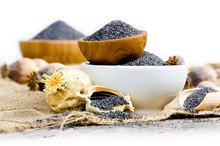Hypericum Perforatum for Nerve Damage
Hypericum perforatum, commonly known as St John's wort, has been used for centuries to treat nerve damage, sciatica and back pain. In more recent years, scientific research has supported use of Hypericum for other nervous system complaints, such as anxiety and depression. The flowers and leaves of Hypericum are full of natural phytochemicals, and can be used internally as well as topically to tone and restore the health of nerves. Hypericum is not intended to be a replacement for standard medical care, however, and you should check with your doctor before using it.
If you are experiencing serious medical symptoms, seek emergency treatment immediately.
History
The name Hypericum is Latin, originating from a Greek word meaning "over an apparition" -- highlighting its folk use to drive away malignant spirits and ghosts. In 1653, Dr. Nicholas Culpeper described the use of Hypericum in his book "The Complete Herbal" for treating wounds, bruises, inflammation, back pain and sciatica 2. Today, use of Hypericum as a nerve restorative herb in treating damage to the nerves and the nervous system continues with modern herbalists and pharmacists.
Chemistry
What Are the Herbs I Should Avoid While Taking Lamictal?
Learn More
Hypericum's actions on the nerves and the nervous system are attributed to the presence of compounds in the aerial flowers and leaves of the plant, including hyperforin, hypericin and psuedohypericin. If you're reading the labels of Hypericum products, you may find these chemicals labeled under the collective name of "total hypericin." According to Kerry Bones, author of "The Clinical Guide to Blending Liquid Herbs," the hypericin and hyperforin is largely anti-depressant and nerve restorative, while pseudohypericin affects viruses, bacteria, wound healing and immune function 3.
Clincial Research
While no research has yet been done on the effects of Hypericum as a topical treatment for nerve damage and nerve pain, one study used Hypericum internally for pain relief. In a clinical trial published in the journal "Pain" in 2001, researchers from the University of Southern Denmark investigated the effects of Hypericum on patients suffering from nerve pain and polyneuropathy. During the trial, patients taking Hypericum experienced a reduction in pain symptoms compared to a placebo, though researchers concluded the effect was not statistically significant. More, larger studies are still required to verify these results, and test the folk use of Hypericum as a topical treatment for nerve and back pain.
- While no research has yet been done on the effects of Hypericum as a topical treatment for nerve damage and nerve pain, one study used Hypericum internally for pain relief.
Safety and Toxicity
Tiger Balm Ingredients
Learn More
According to Drug Information Online, Hypericum is well tolerated and has few side effects 5. Taken internally, Hypericum does stimulate the production of liver enzymes that affect the metabolism of many prescription medications. Because of this, Hypericum should not be taken alongside standard medication, except under a doctor's supervision. Some adverse side effects have been reported, such as increased sensitivity to sunlight, digestive upsets and mania, but these are rare. Consult with your doctor before purchasing Hypericum products.
- According to Drug Information Online, Hypericum is well tolerated and has few side effects 5.
- Because of this, Hypericum should not be taken alongside standard medication, except under a doctor's supervision.
Related Articles
References
- "Wild Drugs"; Zoe Hawes; 2010
- "Culpeper's Complete Herbal"; Nicholas Culpeper; 1995, reprint
- "A Clinical Guide to Blending Liquid Herbs"; Kerry Bones; 2003
- "Pain"; St. John's Wort Has No Effect on Pain in Polyneuropathy; S.H. Sindrup, et al; 2001
- "Drug Information Online": St John's Wort
Writer Bio
Joel Le Blanc is a professional writer for various websites. Le Blanc is currently a student at the University of Canterbury, where he studies English literature, folklore and creative writing. He holds a Diploma in Herbal Medicine and has studied massage, nutrition, bach flowers and reiki.









